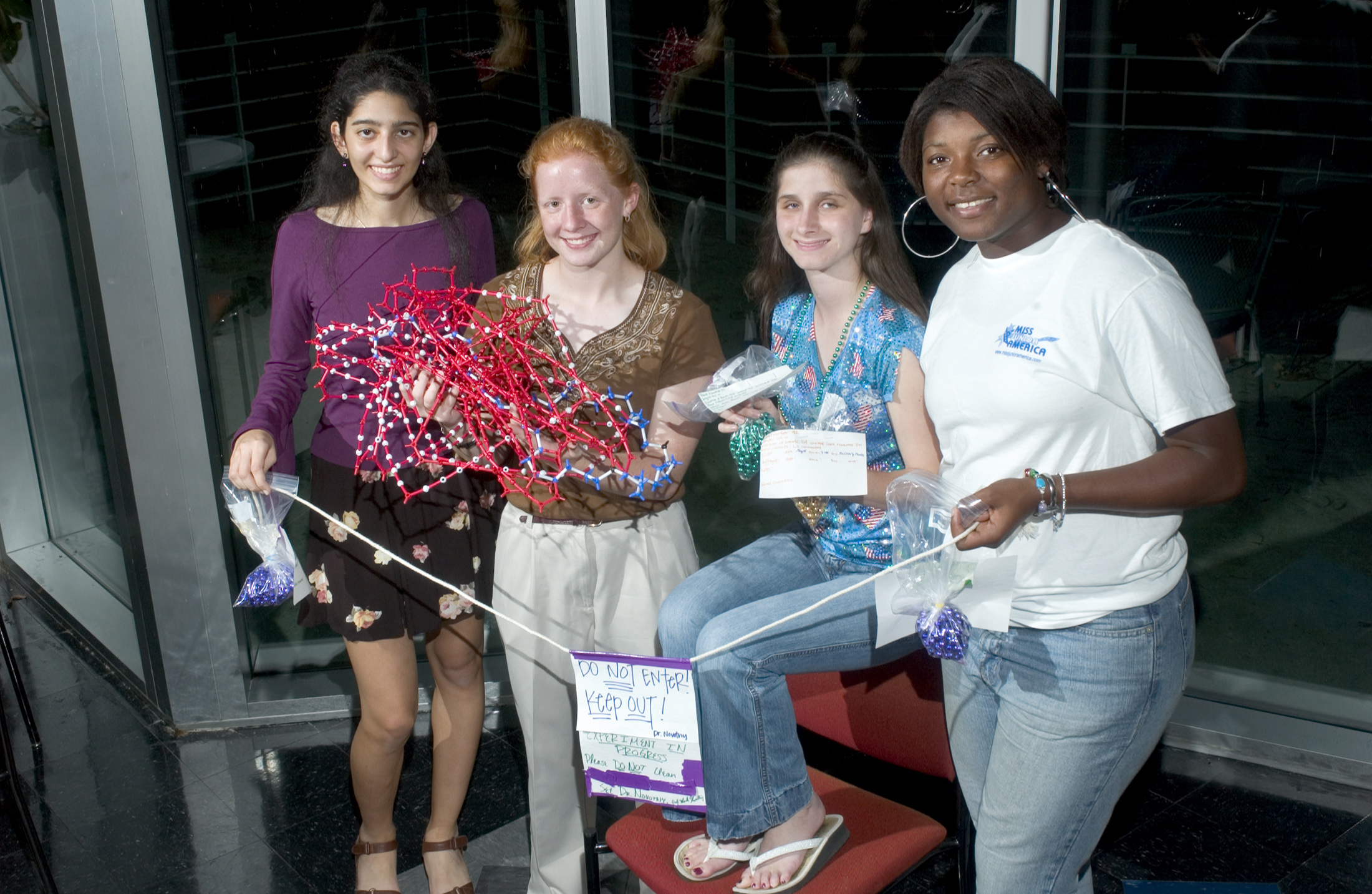Contact: Phil Hearn

MARDI GRAS EXPERIMENT -- Four high school students who used Mardi Gras beads to assist Mississippi State physics professor Mark Novotny in a research project on magnetic materials included (l to r): Sara Gill, a junior at Starkville Academy Melissa Cook, a junior at Starkville High School Amanda Novotny, a junior at the Mississippi School for Mathematics and Science in Columbus and Tori Norwood, a Starkville High senior. Cook is holding a chemical model constructed of Mardi Gras bead necklaces, and the other students are holding bags of numbered Mardi Gras beads.
Four high school students from Starkville used Mardi Gras beads to help a Mississippi State scientist conduct research on magnetic materials.
The recent research project of Mark Novotny, head of the university's physics and astronomy department, focused on the question of whether magnetic materials based on physical "small-world" networks are possible.
"The objective is to make nanomaterials with novel properties--properties that would not be produced by simply taking a nanoscale-size piece of a material," said Novotny, whose research interests include computational materials science and condensed matter physics.
"The idea for small-world nanomaterials is to use the small-world property--six degrees of separation between any two people on earth--for nanomaterials," he explained.
The small-world property is the theory that everyone in the world can be reached through a short chain of social acquaintances. Six degrees of separation refers to the concept that everyone is connected to everyone else in the world by only six degrees of separation, or six sets of acquaintances.
"For example, you are connected to Prime Minister Tony Blair because you know someone who knows someone--and so on for six people--who know Mr. Blair," Novotny said.
Nanotechnology focuses on emerging technology to develop and manufacture precision products at the atomic, molecular or macromolecular levels--that is, approximately 1-to-100 nanometers in size and with each nanometer being equal to about one-billionth of a yard. Nanomaterials can include metals, ceramics, polymeric materials, or composite materials.
One nanometer spans 3-5 atoms lined in a row. By comparison, the diameter of a human hair is about five times larger than a nanoscale particle.
Focusing on the question of whether people can make small-world nanomaterials, Novotny said one possibility was to take chains of atoms, or "atomic necklaces," and "scrunch them up."
"The question addressed here is whether such scrunched-up necklaces have the small-world property, and this is where the high school students came in," the professor noted.
He said the four high school students sequentially numbered beads on two different lengths of Mardi Gras necklaces, then randomly scrunched-up and glued together the necklaces.
"From this day on, Mardi Gras necklaces have an entirely new meaning to me," said Starkville High School senior Tori Norwood.
Junior Amanda Novotny, a Starkville student attending the Mississippi School for Mathematics and Science, said, "Although the work was time-consuming and difficult because of the long, tedious process of numbering both sides of the beads, gluing, then writing down all the glued connections, I feel we accomplished something."
Other students involved in the project included SHS junior Melissa Cook and Starkville Academy junior Sara Gill.
Colin Scanes, MSU's vice president of research and graduate studies, said the participation of high school students in the project was another example of the university's effort "to get young people interested in science by giving them an opportunity to work with cutting-edge researchers."
Mark Novotny, Amanda's dad, said the high school students worked hard on the project for about a month at the ERC (formerly known as the Engineering Research Center).
"They glued together Mardi Gras necklaces to make models for a new class of nanomaterials--a class of materials that introduces ideas of the six degrees of separation into materials," he said.
"The answer (to his research question) is that for two different sizes of necklaces studied, they do have the small-world property," he concluded. "Consequently, there is an incentive for chemists and physicists to construct at the nanoscale, the types of random arrangements the high school students made.
"Our study, to my knowledge, is the first to study packing and connectivity of randomly arranged necklaces," Novotny added. "Working with the students was a joy."
Novotny's paper on the research has been accepted for publication in the Journal of Applied Physics. He was to report on the paper at the Magnetism and Magnetic Materials Conference in Jacksonville, Fla., during November. MSU graduate students Xingjun Zhang, Jeremy A. Yancey and Terrance M. Dubreus assisted in the project.
NEWS EDITORS/DIRECTORS: For more information, contact Dr. Novotny at (662) 325-2688 or Mark Novotny.
--------------------------------------------
LOCAL EDITORS
Melissa Cook is the daughter of Ken and Anne Cook.
Sadie Gill is the daughter of Duane and Sadie Gill.
Tori Norwood is the daughter of Elmer and Mary Norwood.
Amanda Novotny is the daughter of Mark and Ann Novotny.